Global Cellular Modem Market By Type, By Technology, By Application, By Industry Vertical, By Region & Segmental Insights Trends and Forecast, 2024 – 2034
- Industry: Semiconductors & Electronics
- Report ID: TNR-110-1244
- Number of Pages: 420
- Table/Charts : Yes
- August, 2024
- Base Year : 2024
- No. of Companies : 10+
- No. of Countries : 29
- Views : 10085
- Covid Impact Covered: Yes
- War Impact Covered: Yes
- Formats : PDF, Excel, PPT
The global cellular modem market is experiencing significant growth, driven by the rapid adoption of 5G technology and increasing demand for connected devices across industries. Key growth drivers include the expansion of IoT applications, rising mobile broadband subscriptions, and advancements in smart automotive solutions. Market trends indicate a shift towards higher-speed modems and integration with AI-powered devices.
The growing emphasis on smart cities and industrial automation presents lucrative opportunities for market players. Strategic partnerships, continuous innovation, and expanding product portfolios are essential for companies to capitalize on these opportunities. As emerging markets increasingly adopt advanced cellular technologies, the global market is poised for sustained expansion, offering substantial growth potential for industry participants. In terms of revenue, the global cellular modem market was worth US$ 5.3 Bn in 2023, anticipated to witness a CAGR of 19.5% during 2024 – 2034.

Global Cellular Modem Market Dynamics
Global Cellular Modem Market Growth Driver:
The global cellular modem market is driven by the widespread adoption of 5G technology, which promises faster data speeds and low latency, fueling demand across industries. The increasing proliferation of IoT devices, smart cities, and connected vehicles also boosts market growth. Moreover, the expansion of mobile broadband services in emerging economies contributes to the rising demand for cellular modems. As consumers and industries alike prioritize seamless connectivity, the need for advanced, high-speed modems intensifies, propelling market expansion.
Global Cellular Modem Market Restraint:
The global cellular modem market faces restraints including high development and deployment costs associated with next-generation technologies like 5G. Additionally, the complexity of integrating cellular modems with diverse applications and devices poses technical challenges. Market growth is also hindered by stringent regulatory requirements and varying spectrum availability across regions. Moreover, the intense competition among key players exerts pressure on pricing, potentially limiting profit margins and affecting smaller or emerging companies’ ability to compete effectively.
Global Cellular Modem Market Opportunity:
The global cellular modem market presents significant opportunities driven by the rising adoption of smart city initiatives and the increasing demand for connected devices in industrial automation. The expansion of 5G networks offers opportunities for innovation in high-speed, low-latency applications. Emerging markets, particularly in Asia-Pacific and Latin America, offer untapped potential as they continue to develop their telecommunications infrastructure. Additionally, advancements in AI and machine learning integration with cellular modems open avenues for enhanced device performance and new applications, creating growth prospects for market players.
Global Cellular Modem Market Threat:
The global cellular modem market faces threats from rapid technological changes, requiring continuous investment in R&D to stay competitive. Cybersecurity risks associated with increased connectivity pose significant challenges, potentially affecting consumer trust and market adoption. Furthermore, global supply chain disruptions and geopolitical tensions can impact the availability of critical components, leading to production delays and increased costs. The market also faces the risk of regulatory changes that could impose additional compliance burdens, potentially stifling innovation and market growth.
Global Cellular Modem Market Segmental Analysis:
Cellular Modem Market By Type
- Embedded Cellular Modem
- Box Portable Cellular Modem
Embedded cellular modem segment has rapidly emerged as the fastest-growing segment in the global cellular modem market, driven by the increasing demand for compact, integrated connectivity solutions across various industries. These modems are essential in IoT devices, automotive systems, and industrial equipment, enabling seamless and reliable wireless communication. Their ability to provide always-on connectivity in a small form factor makes them ideal for applications where space and power efficiency are critical. As more industries adopt IoT and connected technologies, the demand for embedded cellular modems is expected to continue its rapid growth, offering significant market potential.
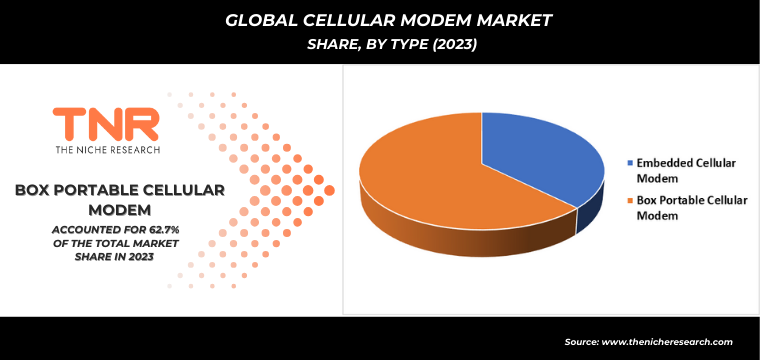
Cellular Modem Market By Technology
- 2G
- 3G
- 4G
- 5G
- NB-IoT
- LTE-M
In 2023, the 5G segment dominated the global cellular modem market, capturing a substantial revenue share of 25.5%. This dominance is attributed to the rapid global rollout of 5G networks, which has accelerated the adoption of 5G-enabled devices across various sectors. The demand for high-speed, low-latency connectivity in applications such as autonomous vehicles, smart cities, and industrial automation has significantly boosted the 5G segment. Additionally, the increasing proliferation of 5G smartphones and consumer electronics has further fueled market growth. As 5G continues to expand globally, its share in the cellular modem market is expected to rise, driven by ongoing technological advancements and broader adoption.
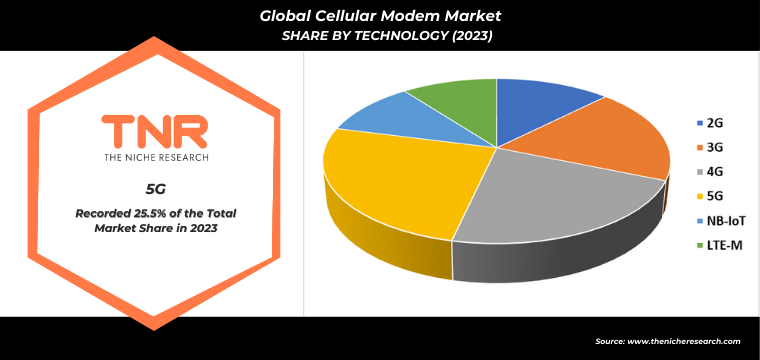
Cellular Modem Market By Application
- IoT Devices
- Portable Devices
Portable devices by application category dominated the global cellular modem market in 2023 with a revenue share of 50.8% owing to increasing demand for mobile connectivity. The widespread adoption of smartphones, tablets, and wearable devices has driven the need for advanced cellular modems that offer reliable, high-speed internet access on the go. The rise of remote work, online learning, and mobile entertainment has further boosted demand for portable devices. Additionally, the integration of cellular modems in laptops and IoT devices has expanded their application scope, contributing to the significant market share in this category.
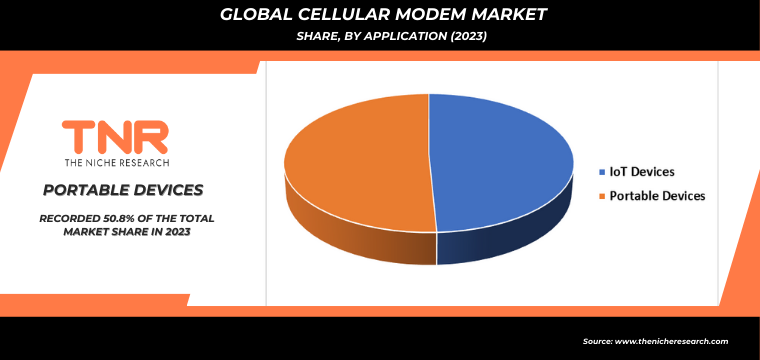
Cellular Modem Market By Industry Vertical
- Agriculture
- Automotive & Transportation
- Building Automation
- Consumer Electronics
- Energy & Utilities
- Healthcare
- Industrial/Manufacturing
- Retail
- Smart Cities
- Others
Consumer electronics emerged as the second leading segment in the global cellular modem market in 2023, capturing a significant revenue share of 15.2%. This growth is driven by the increasing integration of cellular modems in a wide range of consumer devices, including smartphones, tablets, and smart wearables. The rising demand for seamless connectivity and high-speed internet access has fueled the adoption of cellular-enabled consumer electronics. Additionally, the expansion of 5G networks has further accelerated the incorporation of advanced modems in these devices, enhancing user experiences and driving market growth in this segment.

Cellular Modem Market By Region
- North America (U.S., Canada, Mexico, Rest of North America)
- Europe (France, The UK, Spain, Germany, Italy, Nordic Countries (Denmark, Finland, Iceland, Sweden, Norway), Benelux Union (Belgium, The Netherlands, Luxembourg), Rest of Europe)
- Asia Pacific (China, Japan, India, New Zealand, Australia, South Korea, Southeast Asia (Indonesia, Thailand, Malaysia, Singapore, Rest of Southeast Asia), Rest of Asia Pacific)
- Middle East & Africa (Saudi Arabia, UAE, Egypt, Kuwait, South Africa, Rest of Middle East & Africa)
- Latin America (Brazil, Argentina, Rest of Latin America)
Europe is projected to be the fastest-growing region in the cellular modem market during the forecast period, driven by rapid deployment of 5G networks across the continent and strong government support for digital infrastructure initiatives. The region’s robust automotive industry, with increasing adoption of connected and autonomous vehicles, further fuels demand for advanced cellular modems. Europe’s focus on smart city projects and the Internet of Things (IoT) is boosting the need for reliable, high-speed connectivity solutions. The presence of leading technology companies and increasing investments in R&D for innovative modem technologies also contribute to the region’s accelerated growth in the cellular modem market.
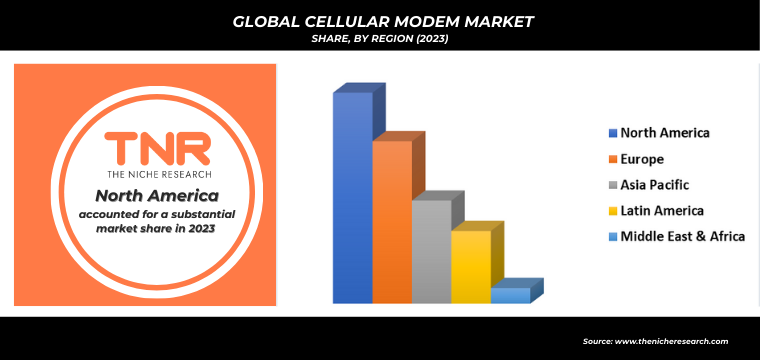
Competitive Landscape
The global cellular modem market is highly competitive, with key players like Cisco Systems, Inc., Digi International Inc., and Huawei Device Co., Ltd. dominating. These companies focus on innovation, 5G technology, and partnerships to maintain their market position. Emerging players and regional manufacturers also compete, driving advancements in performance, connectivity, and cost-effectiveness across various applications.
Some of the players operating in the cellular modem market are
- Advantech Co., Ltd.
- Airgain, Inc.
- Belkin
- Bentek Systems
- Campbell Scientific, Inc.
- Cisco Systems, Inc.
- Digi International Inc.
- D-Link Corporation
- Huawei Device Co., Ltd.
- InHand Networks
- Jinan USR IOT Technology Limited
- LANTRONIX, INC.
- Motorola Mobility LLC
- Moxa Inc.
- Other Industry Participants
Global Cellular Modem Market Scope
| Report Specifications | Details |
| Market Revenue in 2023 | US$ 5.3 Bn |
| Market Size Forecast by 2034 | US$ 37.8 Bn |
| Growth Rate (CAGR) | 19.5% |
| Historic Data | 2016 – 2022 |
| Base Year for Estimation | 2023 |
| Forecast Period | 2024 – 2034 |
| Report Inclusions | Market Size & Estimates, Market Dynamics, Competitive Scenario, Trends, Growth Factors, Market Determinants, Key Investment Segmentation, Product/Service/Solutions Benchmarking |
| Segments Covered | By Type, By Technology, By Application, By Industry Vertical, By Region |
| Regions Covered | North America, Europe, Asia Pacific, Middle East & Africa, Latin America |
| Countries Covered | U.S., Canada, Mexico, Rest of North America, France, The UK, Spain, Germany, Italy, Nordic Countries (Denmark, Finland, Iceland, Sweden, Norway), Benelux Union (Belgium, The Netherlands, Luxembourg), Rest of Europe, China, Japan, India, New Zealand, Australia, South Korea, Southeast Asia (Indonesia, Thailand, Malaysia, Singapore, Rest of Southeast Asia), Rest of Asia Pacific, Saudi Arabia, UAE, Egypt, Kuwait, South Africa, Rest of Middle East & Africa, Brazil, Argentina, Rest of Latin America |
| Key Players | Advantech Co., Ltd., Airgain, Inc., Belkin, Bentek Systems, Campbell Scientific, Inc., Cisco Systems, Inc., Digi International Inc., D-Link Corporation, Huawei Device Co., Ltd., InHand Networks, Jinan USR IOT Technology Limited, LANTRONIX, INC., Motorola Mobility LLC, Moxa Inc. |
| Customization Scope | Customization allows for the inclusion/modification of content pertaining to geographical regions, countries, and specific market segments. |
| Pricing & Procurement Options | Explore purchase options tailored to your specific research requirements |
| Contact Details | Consult With Our Expert
Japan (Toll-Free): +81 663-386-8111 South Korea (Toll-Free): +82-808- 703-126 Saudi Arabia (Toll-Free): +966 800-850-1643 United Kingdom: +44 753-710-5080 United States: +1 302-232-5106 E-mail: askanexpert@thenicheresearch.com
|
Key Developments:
- In August 2023, Renesas, a leading provider of advanced semiconductor solutions, completed the acquisition of cellular IoT specialist Sequans Communications.
- In May 2022, Qualcomm partnered with Viettel to jointly develop a next-generation 5G radio unit featuring massive MIMO capabilities, along with a distributed unit.
Report Layout:
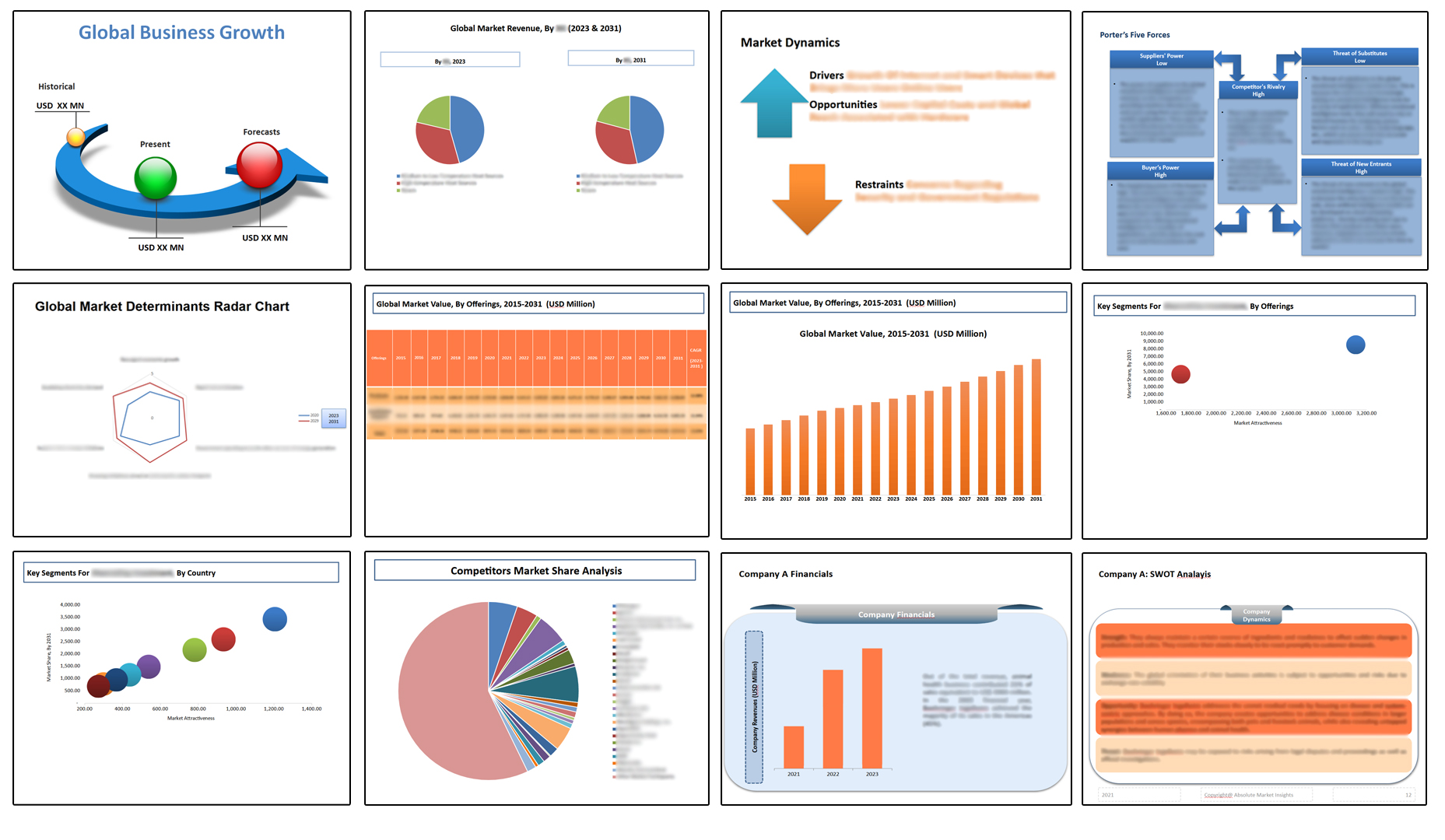
Table of Contents
Note: This ToC is tentative and can be changed according to the research study conducted during the course of report completion.
**Exclusive for Multi-User and Enterprise User.
Global Cellular Modem Market
By Type
- Embedded Cellular Modem
- Box Portable Cellular Modem
By Technology
- 2G
- 3G
- 4G
- 5G
- NB-IoT
- LTE-M
By Application
- IoT Devices
- Portable Devices
By Industry Vertical
- Agriculture
- Automotive & Transportation
- Building Automation
- Consumer Electronics
- Energy & Utilities
- Healthcare
- Industrial/Manufacturing
- Retail
- Smart Cities
- Others
By Region
- North America (U.S., Canada, Mexico, Rest of North America)
- Europe (France, The UK, Spain, Germany, Italy, Nordic Countries (Denmark, Finland, Iceland, Sweden, Norway), Benelux Union (Belgium, The Netherlands, Luxembourg), Rest of Europe)
- Asia Pacific (China, Japan, India, New Zealand, Australia, South Korea, Southeast Asia (Indonesia, Thailand, Malaysia, Singapore, Rest of Southeast Asia), Rest of Asia Pacific)
- Middle East & Africa (Saudi Arabia, UAE, Egypt, Kuwait, South Africa, Rest of Middle East & Africa)
- Latin America (Brazil, Argentina, Rest of Latin America)
The Niche Research approach encompasses both primary and secondary research methods to provide comprehensive insights. While primary research is the cornerstone of our studies, we also incorporate secondary research sources such as company annual reports, premium industry databases, press releases, industry journals, and white papers.
Within our primary research, we actively engage with various industry stakeholders, conducting paid interviews and surveys. Our meticulous analysis extends to every market participant in major countries, allowing us to thoroughly examine their portfolios, calculate market shares, and segment revenues.
Our data collection primarily focuses on individual countries within our research scope, enabling us to estimate regional market sizes. Typically, we employ a bottom-up approach, meticulously tracking trends in different countries. We analyze growth drivers, constraints, technological innovations, and opportunities for each country, ultimately arriving at regional figures.Our process begins by examining the growth prospects of each country. Building upon these insights, we project growth and trends for the entire region. Finally, we utilize our proprietary model to refine estimations and forecasts.
Our data validation standards are integral to ensuring the reliability and accuracy of our research findings. Here’s a breakdown of our data validation processes and the stakeholders we engage with during our primary research:
- Supply Side Analysis: We initiate a supply side analysis by directly contacting market participants, through telephonic interviews and questionnaires containing both open-ended and close-ended questions. We gather information on their portfolios, segment revenues, developments, and growth strategies.
- Demand Side Analysis: To gain insights into adoption trends and consumer preferences, we reach out to target customers and users (non-vendors). This information forms a vital part of the qualitative analysis section of our reports, covering market dynamics, adoption trends, consumer behavior, spending patterns, and other related aspects.
- Consultant Insights: We tap into the expertise of our partner consultants from around the world to obtain their unique viewpoints and perspectives. Their insights contribute to a well-rounded understanding of the markets under investigation.
- In-House Validation: To ensure data accuracy and reliability, we conduct cross-validation of data points and information through our in-house team of consultants and utilize advanced data modeling tools for thorough verification.
The forecasts we provide are based on a comprehensive assessment of various factors, including:
- Market Trends and Past Performance (Last Five Years): We accurately analyze market trends and performance data from preceding five years to identify historical patterns and understand the market’s evolution.
- Historical Performance and Growth of Market Participants: We assess the historical performance and growth trajectories of key market participants. This analysis provides insights into the competitive landscape and individual company strategies.
- Market Determinants Impact Analysis (Next Eight Years): We conduct a rigorous analysis of the factors that are projected to influence the market over the next eight years. This includes assessing both internal and external determinants that can shape market dynamics.
- Drivers and Challenges for the Forecast Period:Identify the factors expected to drive market growth during the forecast period, as well as the challenges that the industry may face. This analysis aids in deriving an accurate growth rate projection.
- New Acquisitions, Collaborations, or Partnerships: We keep a close watch on any new acquisitions, collaborations, or partnerships within the industry. These developments can have a significant impact on market dynamics and competitiveness.
- Macro and Micro Factors Analysis:A thorough examination of both macro-level factors (e.g., economic trends, regulatory changes) and micro-level factors (e.g., technological advancements, consumer preferences) that may influence the market during the forecast period.
- End-User Sentiment Analysis: To understand the market from the end-user perspective, we conduct sentiment analysis. This involves assessing the sentiment, preferences, and feedback of the end-users, which can provide valuable insights into market trends.
- Perspective of Primary Participants: Insights gathered directly from primary research participants play a crucial role in shaping our forecasts. Their perspectives and experiences provide valuable qualitative data.
- Year-on-Year Growth Trend: We utilize a year-on-year growth trend based on historical market growth and expected future trends. This helps in formulating our growth projections, aligning them with the market’s historical performance.
Research process adopted by TNR involves multiple stages, including data collection, validation, quality checks, and presentation. It’s crucial that the data and information we provide add value to your existing market understanding and expertise. We have also established partnerships with business consulting, research, and survey organizations across regions and globally to collaborate on regional analysis and data validation, ensuring the highest level of accuracy and reliability in our reports.








